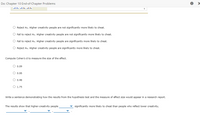
MATLAB: An Introduction with Applications
6th Edition
ISBN: 9781119256830
Author: Amos Gilat
Publisher: John Wiley & Sons Inc
expand_more
expand_more
format_list_bulleted
Question
Answer all parts

Transcribed Image Text:Do: Chapter 10 End-of-Chapter Problems
O Reject Ho. Higher creativity people are not significantly more likely to cheat.
O Fail to reject Ho. Higher creativity people are not significantly more likely to cheat.
O Fail to reject Ho. Higher creativity people are significantly more likely to cheat.
O Reject Ho. Higher creativity people are significantly more likely to cheat.
Compute Cohen's d to measure the size of the effect.
O 0.09
O 0.06
O 0.48
O 1.75
Write a sentence demonstrating how the results from the hypothesis test and the measure of effect size would appear in a research report.
The results show that higher-creativity people
significantly more likely to cheat than people who reflect lower creativity,

Transcribed Image Text:Do: Chapter 10 End-of-Chapter Problems
Recent research has shown that creative people are more likely to cheat than their less creative counterparts (Gino and Ariely, 2011). Participants in
the study first completed creativity assessment questionnaires and then returned to the lab several days later for a series of tasks. One task was a
multiple-choice general knowledge test for which the participants circled their answers on the test sheet. Afterward, they were asked to transfer their
answers to bubble sheets for computer scoring. However, the experimenter admitted that the wrong bubble sheet had been copied so that the correct
answers were still faintly visible. Thus, the participants had an opportunity to cheat and inflate their test scores. Higher scores were valuable because
participants were paid based on the number of correct answers. However, the researchers had secretly coded the original tests and the bubble sheets
so that they could measure the degree of cheating for each participant. Assuming that the participants were divided into two groups based on their
creativity scores, the following data are similar to the cheating scores obtained in the study.
High-Creativity Participants
Low-Creativity Participants
n = 27
n = 27
M = 7.41
M = 4.78
SS = 749.5
SS = 830
Use a one-tailed test with a = .05 to determine whether these data are sufficient to conclude that high-creativity people are more likely to cheat than
people with lower levels of creativity.
Pooled Variance
Estimated Standard Error
t Statistic
Critical Values
Expert Solution
This question has been solved!
Explore an expertly crafted, step-by-step solution for a thorough understanding of key concepts.
This is a popular solution
Trending nowThis is a popular solution!
Step by stepSolved in 5 steps with 5 images

Knowledge Booster
Similar questions
Recommended textbooks for you
 MATLAB: An Introduction with ApplicationsStatisticsISBN:9781119256830Author:Amos GilatPublisher:John Wiley & Sons Inc
MATLAB: An Introduction with ApplicationsStatisticsISBN:9781119256830Author:Amos GilatPublisher:John Wiley & Sons Inc Probability and Statistics for Engineering and th...StatisticsISBN:9781305251809Author:Jay L. DevorePublisher:Cengage Learning
Probability and Statistics for Engineering and th...StatisticsISBN:9781305251809Author:Jay L. DevorePublisher:Cengage Learning Statistics for The Behavioral Sciences (MindTap C...StatisticsISBN:9781305504912Author:Frederick J Gravetter, Larry B. WallnauPublisher:Cengage Learning
Statistics for The Behavioral Sciences (MindTap C...StatisticsISBN:9781305504912Author:Frederick J Gravetter, Larry B. WallnauPublisher:Cengage Learning Elementary Statistics: Picturing the World (7th E...StatisticsISBN:9780134683416Author:Ron Larson, Betsy FarberPublisher:PEARSON
Elementary Statistics: Picturing the World (7th E...StatisticsISBN:9780134683416Author:Ron Larson, Betsy FarberPublisher:PEARSON The Basic Practice of StatisticsStatisticsISBN:9781319042578Author:David S. Moore, William I. Notz, Michael A. FlignerPublisher:W. H. Freeman
The Basic Practice of StatisticsStatisticsISBN:9781319042578Author:David S. Moore, William I. Notz, Michael A. FlignerPublisher:W. H. Freeman Introduction to the Practice of StatisticsStatisticsISBN:9781319013387Author:David S. Moore, George P. McCabe, Bruce A. CraigPublisher:W. H. Freeman
Introduction to the Practice of StatisticsStatisticsISBN:9781319013387Author:David S. Moore, George P. McCabe, Bruce A. CraigPublisher:W. H. Freeman

MATLAB: An Introduction with Applications
Statistics
ISBN:9781119256830
Author:Amos Gilat
Publisher:John Wiley & Sons Inc

Probability and Statistics for Engineering and th...
Statistics
ISBN:9781305251809
Author:Jay L. Devore
Publisher:Cengage Learning

Statistics for The Behavioral Sciences (MindTap C...
Statistics
ISBN:9781305504912
Author:Frederick J Gravetter, Larry B. Wallnau
Publisher:Cengage Learning

Elementary Statistics: Picturing the World (7th E...
Statistics
ISBN:9780134683416
Author:Ron Larson, Betsy Farber
Publisher:PEARSON

The Basic Practice of Statistics
Statistics
ISBN:9781319042578
Author:David S. Moore, William I. Notz, Michael A. Fligner
Publisher:W. H. Freeman

Introduction to the Practice of Statistics
Statistics
ISBN:9781319013387
Author:David S. Moore, George P. McCabe, Bruce A. Craig
Publisher:W. H. Freeman